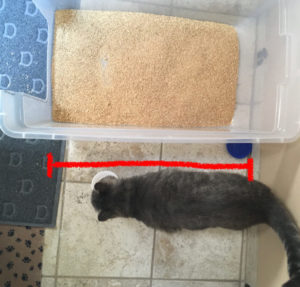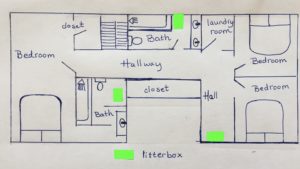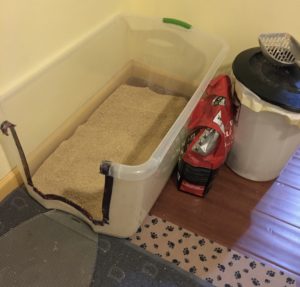Did you know that kitty litter has been with us since 1947? Edward Lowe began promoting fuller’s earth, an absorbent clay, as a cat box filler in 1947. Our cats began to lead an indoor existence. What do cat guardians need to know about this essential feline resource – what are the litter box basics?
In the wild…
Cats look for a secluded quiet place to relieve themselves as they are vulnerable to predators while eliminating. They prefer sand or fine dirt for elimination; they bury their waste when in their core territory. Feces and urine can be used to message other cats, so outside this core territory, cats will sometimes leave their waste unburied.
A cat’s core territory is his home base, where he can shelter and rest. He will actively defend this area.
The Cat Friendly Home: Litter Box Basics….
The Box…
There are litter boxes with covers, litter boxes without covers; top-entry litter boxes, litter boxes that fit in end tables. Choose a litter box that suits your cat’s personality and physical condition.

Covered Litter Boxes
- Your cat’s waste is out of sight
- Out of sight = out of mind ? It may be easier to neglect scooping the litter box.
- Ambush opportunity: the cat using the box will not see other cats, people, or dogs approaching.
How Large?
The litter box needs to be large enough for your cat to enter and turn around, about 1.5 times her length (without tail)
High Sides?
- An older arthritic cat may prefer low walls or a low door cut into the box.
- Managing cats that urinate while standing might be easier with a high-sided litter box.
Location, Location, Location…
Where you locate the litter box can make all the difference to your cat. Choose a quiet, secluded place.
- Avoid noisy utility rooms where appliances running can startle your cat.
- Avoid high-traffic busy areas where toddlers or the family dog can ambush your kitty.
- A gadget called a “door buddy” can make a closet a safe litter box location.
- Bathrooms can be good choices for litter boxes – cleaning may be easier in these areas.
Litter boxes should be far away (at least 5-6 feet) from either food or water sources. After all, you don’t dine in your bathroom!
What Goes in the Box…
- Cats typically prefer a fine textured, clumping litter
- Cats have a sense of smell that is thousands of times more sensitive than ours. It is best to use unscented varieties of litter.
- Experts recommend a litter depth of about 1.5 inches.
# of Cats + 1

Experts recommend that there should be at least one litter box per cat plus one. This is not a hard and fast rule – it depends on the number of feline social groups in the house and the layout of the house itself. All cats must have ready access to this critical resource.
Social Groups and Litter Boxes
There is less conflict and less competition for resources among cats of the same social group. Cats of the same social group are less likely to engage in behaviors such as “guarding” a litter box from each other.
House Plans and Litter Boxes
Larger houses and multi-story houses may require a different litter box allocations. Once again, the goal is easy access – for example, in a 3 story house, there should be at least 3 litter boxes, one on each floor of the house.
.
How do I know which cats are part of a social group? Look for “affiliative” behavior: cats belonging to the same social group will groom each other and sleep together.
Scoop, Scoop, Scoop!

- Scoop the boxes once or twice daily.
- Keep a small trash can next to each box to make this chore easier or use a higher-tech solution such as a Litter Genie Pail.
- Cleaning the box and changing out clumping litter can be done every 2-4 weeks IF YOU SCOOP DAILY.
- Respect the cat’s sense of smell and use a mild detergent when cleaning the box.
Feces and urine smells are not as distasteful to cats as they are to us – urine and feces can convey messages between cats. Scooping the box MORE frequently and changing out the litter LESS frequently will keep your cat happier by maintaining the scent profile of your cat’s home.


karen gifford says:
I had never heard of the door buddy, what a great idea.